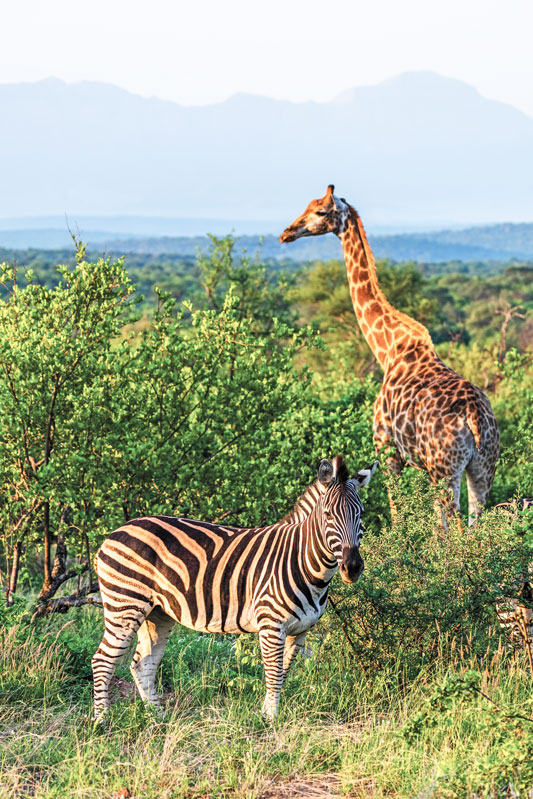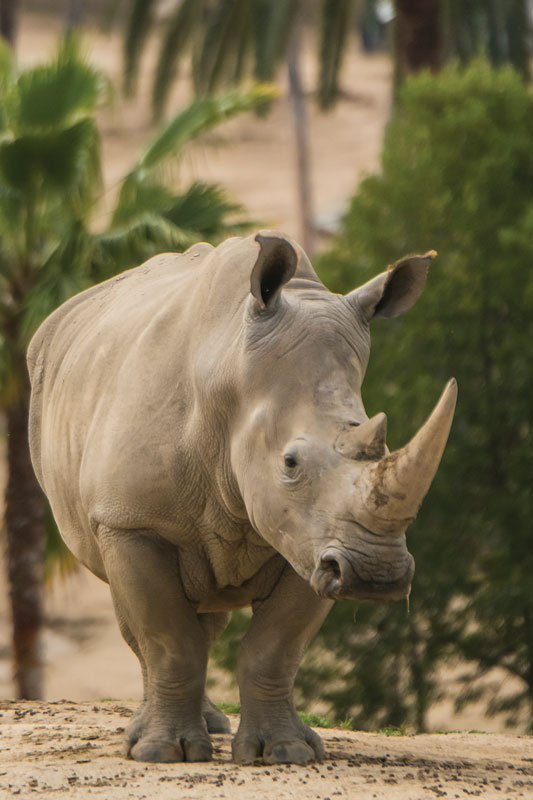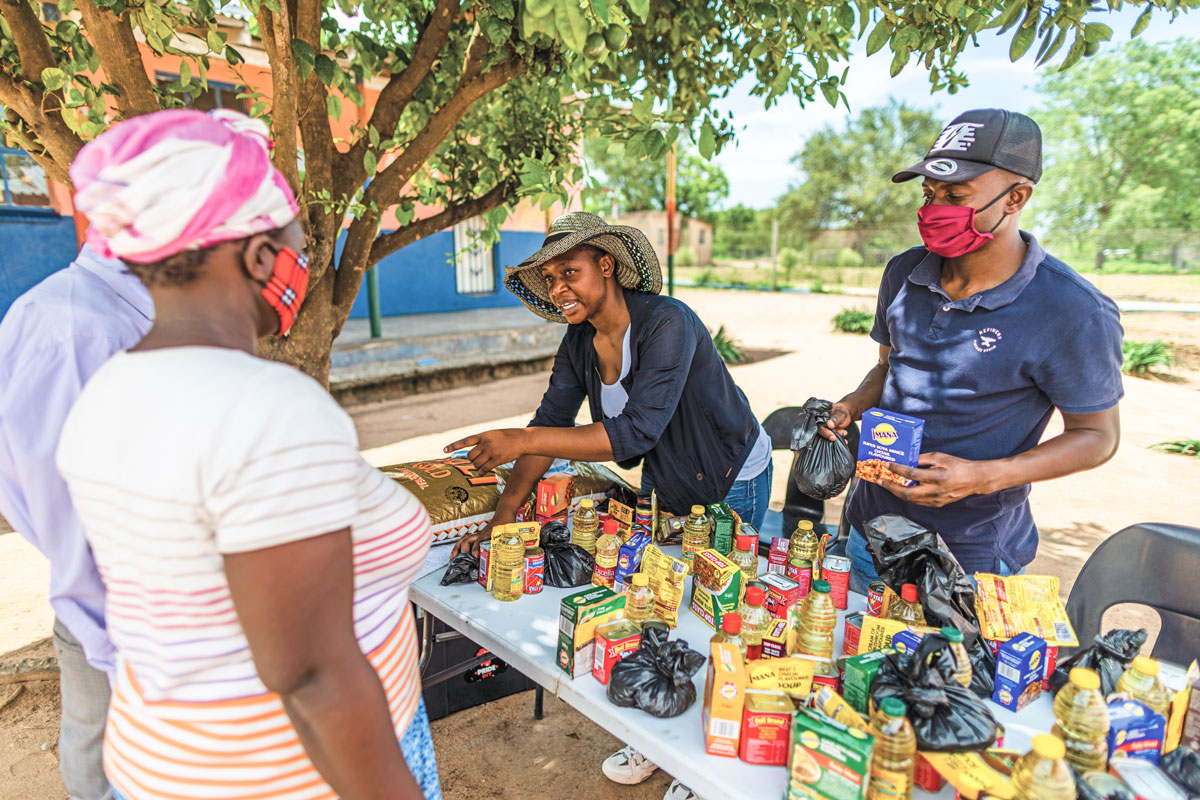White Rhinos and Black Mambas Can an all-female anti-poaching unit stop wildlife crime in an African game preserve — without guns?
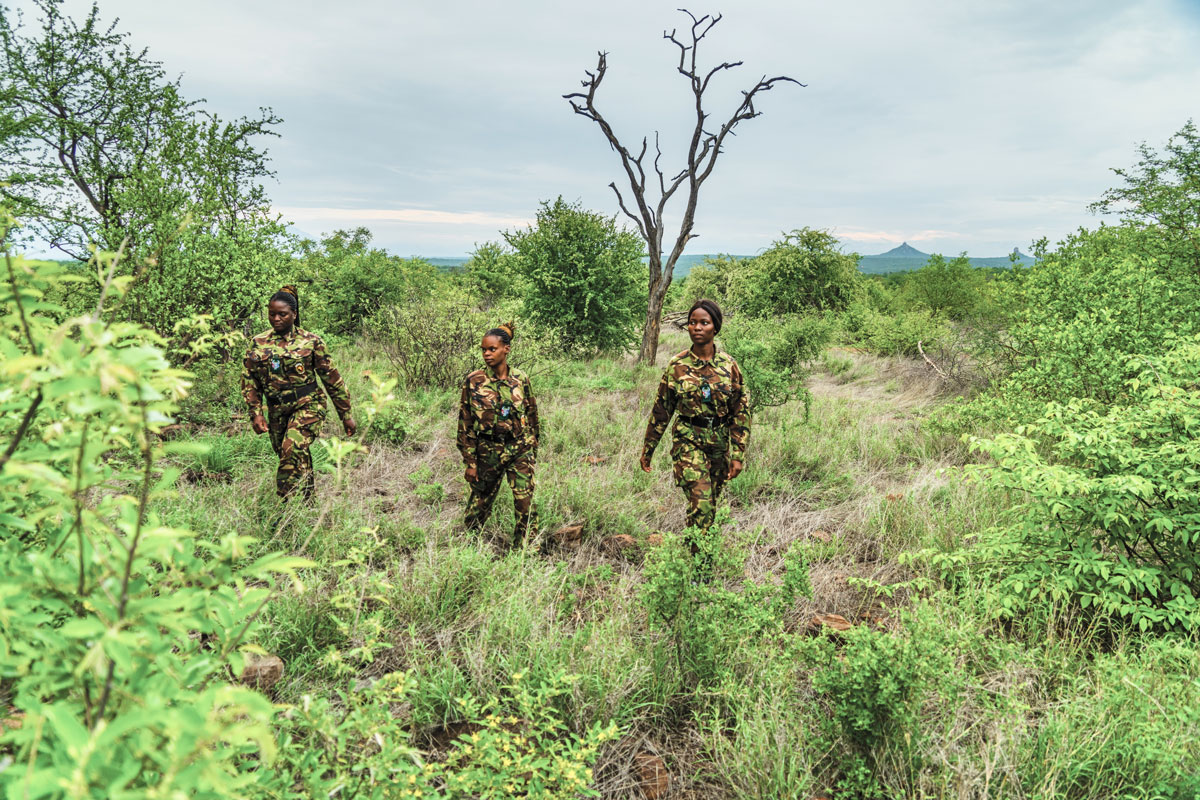
Dressed in a baggy green camouflage uniform and black work boots, long ponytail swinging against her back, Tsakane Nxumalo, 26, and her partner Naledi Malungane, 21, stride alongside an elephant-proof electric fence that is 7-feet-high and nearly 100 miles long. The potent, honey-like odour of purple-pod cluster-leaf trees hangs heavy in the humid summer air, while overhead a yellow-billed hornbill swoops to perch on the skeleton of a dead leadwood tree. Tsakane and Naledi are members of the Black Mambas Anti-Poaching Unit. Named after a snake that is native to the region and long, fast and highly venomous, the Mambas strive to protect the animals of the Balule Nature Reserve within Greater Kruger National Park, a South African wilderness that is about the size of Israel.
Tsakane and Naledi, who both grew up near the unit’s headquarters but only got to know each other since they became Mambas, are checking, as they do every day of their 21-day shift, for breaches in the fence. Mostly this entails collecting rocks to shore up the places where animals such as warthogs and leopards have tried to burrow their way under, but periodically they come across a spot where humans have cut the fence to hunt animals for bushmeat or, worse, poach rhinos for their horns.
In 2013, when the first Mambas began patrolling the reserve, they quickly discovered that rhino poaching was only part of the problem. The park was also losing hundreds of animals of all species to snares every year. “It was embarrassing,” recalls Craig Spencer, 48, as he sits by a bushveld braai (barbecue) and talks over the calls of a nearby hyena. A maverick South African conservationist, he was head warden of Balule, a private animal preserve. “I should have known what was happening under my nose. It took the Mambas to show me what was going on.”
White rhinos have been hunted almost to extinction in Africa. Of the continent’s 18,000 remaining white rhinos, nearly 90 per cent are in South Africa, the species’ last best hope. Kruger is home to by far the biggest white rhino population, as well as about 300 of the world’s 5,600 remaining black rhinos.
The rhinoceros horn is prized in some countries, used as a traditional medicine and a status symbol. According to the Wildlife Justice Commission, a horn fetches an average of $4,000 per pound in Africa, and as much as $8,000 per pound in Asia; given that a set of white rhino horns typically weighs 11 pounds, it’s worth between $44,000 and $88,000. South Africa’s per capita income is about $5,000 per year and its pre-Covid-19 unemployment rate was about 29 per cent. Therefore, a rhino, sadly, is a tempting target. In 2017, poachers killed more than 500 rhinos in Greater Kruger National Park, including 17 in Balule.
“Poachers make me angry,” Tsakane says, because they are killing the animals that all South Africans should be preserving for future generations. While Tsakane is fully aware that some people poach only out of a desperation to feed their families, her commitment to the cause is unwavering. She points out that it would be devastating for both tourism and conservation to lose a member of what’s called the “Big Five,” an old hunting term that refers to the five most sought-after animals in Africa: lions, leopards, elephants, buffalo, and rhinos. Rhinos, along with elephants, are keystone megaherbivores that shape the landscape in ways that benefit other species. And the big animals in any ecosystem are usually the canaries in the coal mine, to abuse the phrase. “If we can’t prevent keystone species from going extinct,” says Tom Tochterman, “other species are also doomed.”
Since 2009, when he had an “aha!” moment during his first photo safari in South Africa, Tochterman, 60, has been a passionate supporter of this nature reserve. A retired real estate developer and a member of the Rotary Club of Chelan, Washington, he has since founded a nonprofit called Rhino Mercy, which strives to fight rhino poaching, and developed a luxury photo-safari programme that helps to fund conservation work. He also earned a PhD by researching the influence of cognitive dissonance on the consumption of natural resources and ecosystem degradation.
The black mambas name symbolises how seriously they took their opportunity to enter an industry that had previously been off-limits to women.
In addition, Tochterman was a founding member of the Rotary Action Group for Endangered Species (RAGES), which has the goal of improving the lives of people by improving the habitats and lives of endangered animals of all types. He welcomes the recent addition of protecting the environment to Rotary International’s Areas of Focus. “We firmly believe that healthy landscapes contribute to healthy communities,” he says, adding that “the Mambas have shown that the reverse is also true.”
In 2010, Tochterman was at a bush camp, sitting around a campfire with Spencer, the former game warden who is now his close friend and partner, drinking rum and coke and talking long into the night, when they lit a spark that would grow to become the Mambas. “Across Africa, the default response to poaching has been to bring in more men with more guns,” Tochterman says. “And it hasn’t worked anywhere.” It dawned on them that the only way to change the narrative was to shape the minds of the next generation, and that the best way to reach the children was through their mothers.
Tochterman and Spencer eventually learned about a government programme to employ women as environmental monitors in conventional agriculture; they thought they could maybe stretch the job description to include “game ranger,” but senior management at South African National Parks questioned the concept of unarmed women operating in areas where lions, leopards, rhinos, elephants and buffalo roam free. Tochterman was told on more than one occasion that this was a “stupid, dumb idea” that “could only have come from America.”
When the two men were finally given a chance to put their theory into action, the candidates shortlisted by bureaucrats in the government programme were told what the job would entail — and they all quit. So Spencer and Tochterman got permission from the local chiefs to go into communities near the park and look for the right kind of people. The Black Mambas name was chosen by the first group, says Tochterman, symbolising “how seriously they took their opportunity to enter an industry that had previously been off-limits to women. They wanted to make a statement that they were not window dressing.”
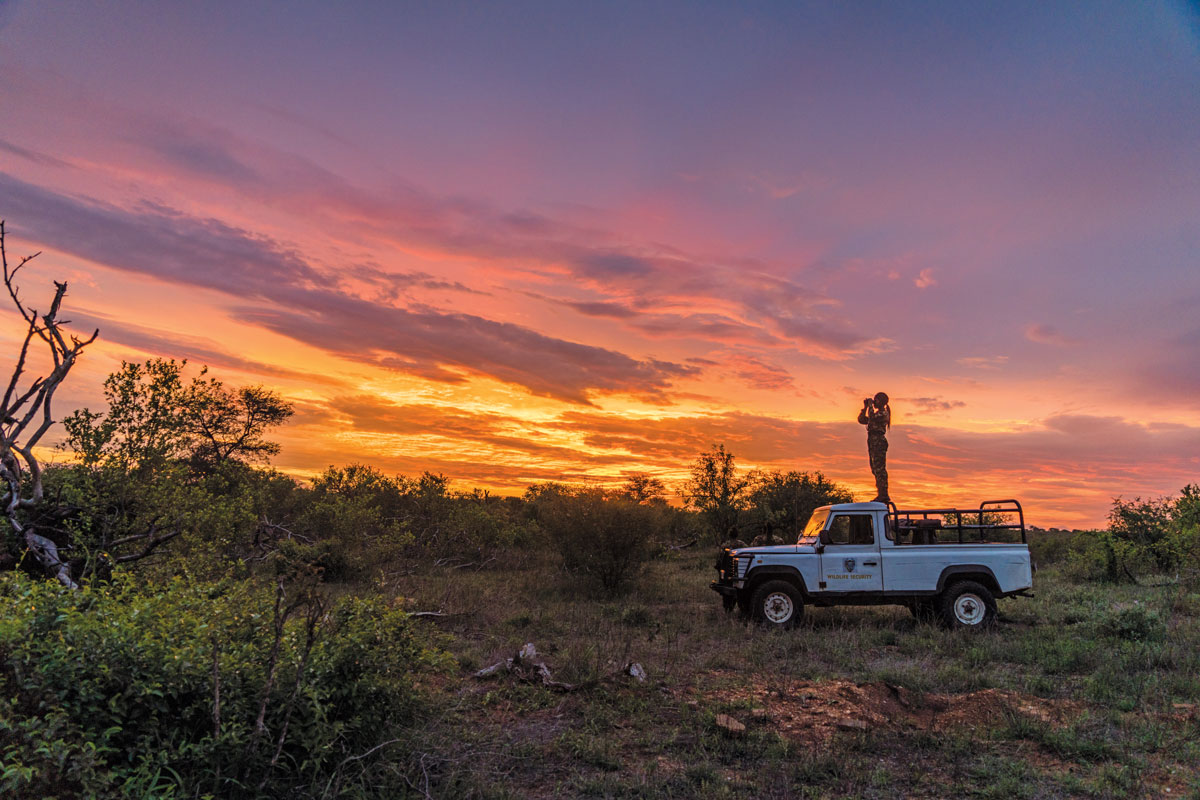
Word quickly spread, and within months the Mambas were receiving unsolicited applications from local women almost every day. Since the beginning, the day-to-day operations of the Mambas have been managed by Spencer’s nonprofit, Transfrontier Africa. Tochterman was key in building and financing the Mambas’ operations hub as well as the separate compound where the women stay during their shifts. He had also spent six years in the military police, so he was able to provide training in skills such as handcuffing a person. Tochterman’s Rhino Mercy nonprofit acts as the Mambas’ international fundraising arm, and it has brought them financial security. The government recently stopped funding the women’s basic salaries (around $450 per month), which was a small fraction of the total cost of the programme. Tochterman says that all told, employing one Mamba costs upwards of $50,000 per year.
Nkateko Mzimba, who was part of the Mambas’ second cohort in 2014, remembers many men in her hometown teasing her about the job and belittling her chances of survival in what they deemed to be a man’s world. Their predictions very nearly came true when, during her first few months with the Mambas, she and two colleagues were repeatedly charged by a pride of lions and had to be rescued from a tree by a passing vehicle. “I tried to quit,” she remembers. “But after counselling I decided to stay and prove the doubters wrong.” Looking back, Nkateko, now a sergeant who will soon qualify as a professional field guide, realises that the whole situation could have been avoided if she had better read the lions’ behaviour.
Nkateko now ensures that every patrol includes a veteran Mamba and that armed response is always on standby. (The Mambas’ every move is tracked from a central operations room.) In their first year, it was not uncommon for the Mambas to find 70 snares in a day. They also came across several “bushmeat kitchens,” large operations for butchering and drying meat, within the reserve itself.
One full moon night in 2015, a patrol of Mambas responded to the sound of gunfire and startled a group of poachers who had just killed a rhino. After briefly giving chase in their vehicle, the Mambas returned to the scene to find two rhinos dead and a third one wounded. Despite the best efforts of emergency veterinarians, the third, too, succumbed. The only small mercy of this grisly episode was that the poachers didn’t get their prize.
Knowing that the Mambas have played a part in reducing poaching feels “really amazing,” says Tsakane, more so because it’s a job that she says she grew up thinking was “supposed to be done by men.” To this day, many in the conservation industry in South Africa still feel that women have no place in the anti-poaching arena and that conducting unarmed patrols in Big Five areas is foolhardy. “I don’t think men would want to work unarmed in a Big Five area,” says Tsakane with a laugh. “A man would come up with so many reasons why he needs a gun. But for us it’s more about reading the animals’ behaviour. We understand that it’s not really about guns.”
Through their community connections, the Mambas are also helping to change the cops-and-robbers narrative that has plagued the conservation movement in South Africa since its inception. While nature conservation is often depicted as noble protectors of the environment doing battle with evil poachers and exploiters, this ignores more complex social, political and economic realities. Shortly after the land that would become the Kruger National Park was set aside and protected in 1898, some 3,000 people belonging to the Tsonga ethnic group were forcibly removed from the land. Fences were erected, national borders that had previously been recognised only on maps were enforced, and people were fined or imprisoned for “trespassing” on the land they had always lived on and hunting the animals they had always eaten. During apartheid, the fences became more impenetrable and the sentences harsher.
This history is vital to understanding how rangers and poachers can come from the same communities — or families. And it’s why many of the people who have lived their entire lives on the fringes of one of the world’s most iconic national parks know almost nothing about it.
Tsakane had been to Kruger a few times, but had no real affinity with the bush. After passing a panel interview and a fitness test with flying colours, she and eight other recruits, including Naledi, began their basic training. Training was hard, she says, involving exercises such as “running the whole day in the sun with only a small bottle of water.” Now she looks back on that time with appreciation: “Training gave me that go-ahead, that I can be more and do more.”
If the rhinos go extinct, the poachers will move on to the elephants, the pangolins, the lion-bone trade. Conservation is about saving all the animals.
After racking up thousands of kilometres of foot patrols in Big Five areas, Tsakane loves the bush and remains devoted to the cause. She’s not alone — all of the women from her cohort are still Mambas. And they’re proud to pass on what they’ve learned. “We won’t only teach our own kids; we will tell other girls that they can do anything,” Tsakane says. “We are telling every lady out there that you can do more, you can be more.” While they never go home in their uniforms (a poacher could steal one from a clothesline and use it to infiltrate the park), Tsakane makes no attempt to hide what she does. “You have to be proud of what you do,” she explains. “This inspires others to walk tall. I’ve always known I could do a lot. But the Mambas really brought it out of me.”
The Mambas’ salary is considered quite good for the area, so in addition to using her income to support her mother and her sister, Tsakane has been paying her own university fees. She recently completed the first year of a teaching degree online. Nkateko uses her income to fund and run a food pantry for hungry neighbours — which further aids in reducing poaching.
A typical day for the Mambas involves rising at dawn for a fence patrol or snare sweep (both on foot) and conducting nightly observations from a blind or vehicle. Gunshots, torchlight, and the smell of tobacco smoke are all telltale signs of poacher activity, but these days Tsakane says the Mambas are more likely to be interrupted by a leopard or a herd of elephants. “They are so peaceful at night,” she says. “Sometimes they block the way, but we never rush them.”
Weekly tasks for the Mambas include searching the compounds where reserve staff and contractors live, conducting roadblocks, and speaking to tourists and local communities about the importance of wildlife conservation. “If nothing happens on a patrol, that is a big success,” Tsakane says. “If I don’t find any snares, that is a bonus because it means that no one has come in to plant a new snare and no one has cut the fence since I last checked it. It’s a huge relief.”
The Mambas programme got a boost in 2015 with the arrival of Lewyn Maefala, an energetic nature conservation student with an infectious laugh. Lewyn did a yearlong practicum with Spencer’s nonprofit for her coursework at the Tshwane University of Technology and hasn’t left since. She noticed that although the Mambas were patrolling fences and protecting the animals from poachers, they weren’t doing much prevention work in the communities the poachers came from. Within a few months, Lewyn received permission to teach an environmental education programme for students at four local primary schools.
Calling her programme the Bush Babies, Lewyn focused on using animals that the students were likely to come across in the field as a way to teach about ecosystems conservation. “We talk about the animals and how they fit into the local culture,” she says, giving the example of the Shai people in Ghana, who love “dancing to elephants,” their totem animal. But the Bush Babies also learn why animals need clean water and healthy trees to survive. And they are taught to unlearn the belief, passed down from their elders, that snakes and scorpions should be killed. “Just the other day, some of my Bush Babies found a puff adder,” Maefala says. “Together we released it into the wild, far away from the community. That would never have happened a few years ago.”
By 2017, Lewyn had expanded the programme to include 10 schools, two grade levels, and more than 1,000 students. She also took advantage of the same government-funded environmental monitors initiative to hire several young men and women to teach the Bush Babies. Never one to sit still, Lewyn has integrated the programme with the school curriculum (math students, for example, might record the species, age and sex of all the animals they see on a game drive and use that data to create a mini-census) and started a vegetable-gardening project where children oversee the entire process, from mulching the soil to cooking the produce. She has also initiated a Bush Grannies programme, which taps into local grandmothers’ deep wells of knowledge, and teamed up with a local organisation affiliated with Scouts South Africa to ensure that her programme also reaches adolescents. Last year over 1,500 teens attended Scout meetings at the Bush Babies Environmental Education Centre. Says Spencer appreciatively, “Lewyn has taken the Bush Babies to the moon.”
By the time Tsakane joined the Mambas in 2019, the programme was at full capacity (36 Mambas including the Bush Babies team), and community attitudes about female rangers had softened considerably. “When I go home to my village, the other women ask me if there are any vacancies at the Mambas,” she says. “It feels really good to change mindsets, to show people that women can make a real difference in the fight against poaching.”
Aided by a combination of Covid-19 related travel restrictions, which have made it harder to move rhino horns across borders, an apparent reduction in demand for the horns in Southeast Asia, and the fact that there are fewer rhinos left to kill, there is evidence that rhino poaching has slowed. In the first half of 2021, poachers killed 249 rhinos in South Africa — a considerable decline from 2013 to 2017, when they killed more than 1,000 per year. And within the Mambas’ territory, poachers have killed just one rhino since the beginning of 2020.
The Mambas now plan to implement a formal high school and/or vocational training programme in the near future, and to expand across South Africa and beyond, in places where the demand has been strong not only to protect land but to involve more women. The only thing holding them back has been the lack of funding to make it happen. “We will continue to strengthen our programmes despite the complications brought on by the global pandemic to ecotourism and conservation initiatives in general,” Tochterman says.
Lewyn’s Bush Babies programme has inspired two members of its first graduating class to pursue nature conservation degrees. She would love to see every school in the province implement her programme, and she also has her eye on a 100-seat bus (“Imagine taking 100 kids to see the Kruger Park!”) and a “really big” Bush Babies resource centre with a library and internet access. “Finding the people to run the programme isn’t a problem,” she says. “I could find a hundred people tomorrow, but we barely have enough money to run the programme in 10 schools.”
This, says Tsakane, is just one more obstacle that must be overcome. “We need to have Mambas working across the park,” she says. “If the rhinos go extinct, the poachers will move on to the elephants, the pangolins, the lion-bone trade. We need the elephants to trample over trees so the impalas can eat. The lions need the impalas to survive. Conservation is about saving all the animals. This is why the work we are doing is so important.”
Nick Dall is a freelance writer based in Cape Town, South Africa
Pictures by Bobby Neptune
©Rotary
On the wild side
The Rotary Action Group for Endangered Species (RAGES) helps clubs and districts design environmental projects. The group launched in 2015 with the support of famed conservationist Jane Goodall boasts nearly 1,000 members across 71 countries.
“Healthy landscapes lead to healthy communities,” says Tom Tochterman, who chairs the action group. “Rotary is all about healthy, safe, and prosperous communities. Without a healthy landscape, the cards are stacked against you.”
Put your club’s project on the map; visit rag4es.org to submit the details.
Mountain gorillas
Democratic Republic of Congo, Rwanda and Uganda
Only about 1,000 mountain gorillas remain in the world, although the numbers are slowly increasing due to conservation efforts. Mountain gorillas have thicker fur than other great apes to help them survive the colder weather at higher elevations. Their biggest threats are habitat loss, political instability and human encroachment; because mountain gorillas share more than 98 per cent of their DNA with humans, they are susceptible to human diseases such as flu and pneumonia.
The Mountain Gorilla Conservation Society of Canada, led by Rotarian Raemonde Bezenar, is working to increase the number of wildlife veterinarians through scholarships in wildlife health and management at universities in the Democratic Republic of Congo, Rwanda and Uganda. The Rotary clubs of Edmonton Riverview, Alberta, and Kampala Munyonyo, Uganda, worked with RAGES to secure three global grant scholarships for the wildlife health programme.
Pollinators
Guatemala
More than 75 per cent of the world’s leading food crops rely on pollinators, whether bees, birds, butterflies, beetles or bats. Pollinators are also responsible for much of the world’s oils, fibres and raw materials. But habitat loss, climate variability and pesticides are hastening the decline of these species.
The Rotary Club of Carpinteria Morning launched the Save Me Peace Project in the Lake Atitlán basin, where a number of hummingbird species are threatened. Through the citizen-science initiative, club members taught schoolchildren about the importance of pollinators and their habitats. The club partnered with RAGES to host a virtual symposium on pollinators at the Universidad del Valle de Guatemala.
Great apes
Cameroon
Habitat destruction threatens Africa’s great apes — gorillas, chimpanzees and bonobos — due to logging for tropical hardwood and the illegal commercial bushmeat trade. Subsistence hunters have killed wild animals to provide food for their families for thousands of years, but today, commercial hunters kill entire primate families, putting the long-term prospects of these animals at risk.
Ape Action Africa, sponsored by the Rotary Club of Pickering, Ontario, rescues orphaned great apes, and local community members are among the caregivers for the young animals in Cameroon’s Mefou primate sanctuary. The organisation also educates local schoolchildren about bushmeat, logging, conservation, and other environmental issues, and is working to identify areas to protect as habitat so that the animals can be released back into the wild.
Orangutans and pygmy elephants
Indonesia and Malaysia
Orangutans used to live across Southeast Asia, but today they exist only in fragmented forest patches on the islands of Borneo and Sumatra. The animals’ preferred habitat has given way to plantations of acacia, rubber, and palm: Indonesia and Malaysia produce 90 per cent of the world’s palm oil, which is found in half of the world’s supermarket products. Habitat destruction has similarly affected the Bornean pygmy elephant, an Asian elephant subspecies which is found only in Borneo and has an estimated population of fewer than 1,500.
Orangutan Appeal UK works with the Sepilok Orangutan Rehabilitation Centre in Malaysian Borneo to care for orphaned animals. The organisation, founded by Susan Sheward of the Rotary Club of Bookham & Horsley, England, funds staff at the centre and supports a wildlife rescue unit, reforestation efforts and
habitat protection.
Rhinos
South Africa
Every 22 hours a rhino is killed for its horns in South Africa, home to the majority of the world’s rhinos. Poachers killed more than 1,000 rhinos each year between 2013 and 2017. Rhino horns are used in traditional Chinese medicine and, increasingly, as a status symbol; sophisticated international criminal gangs are often behind the poaching.
The Chipembere Rhino Foundation (chipembere means `rhinoceros’ in Shona, an African language) supports anti-poaching efforts by providing specially trained tracking and apprehension dogs, technology for monitoring rhinos, and ranger equipment. The Rotary Club of Kenton on Sea, South Africa, is a longtime supporter of the organisation. Rhino Mercy, which Tochterman founded, co-developed the Black Mambas anti-poaching unit, the first all-female group of its kind in South Africa, and supports environmental education and scientific research.

